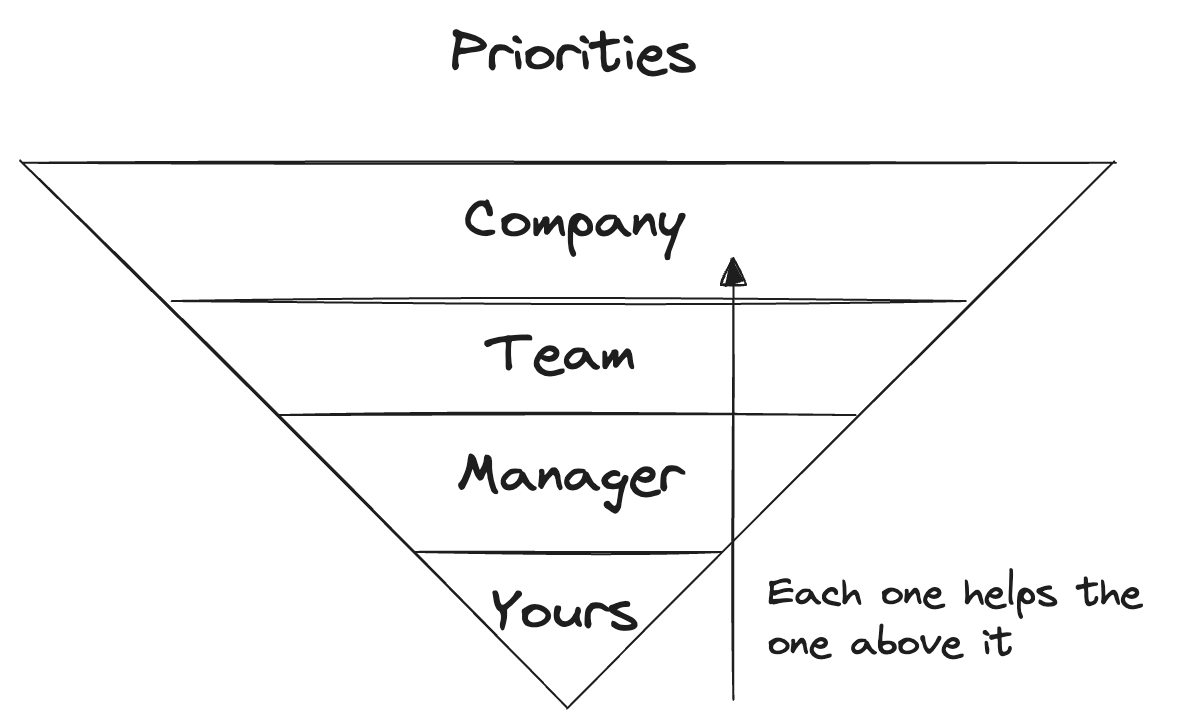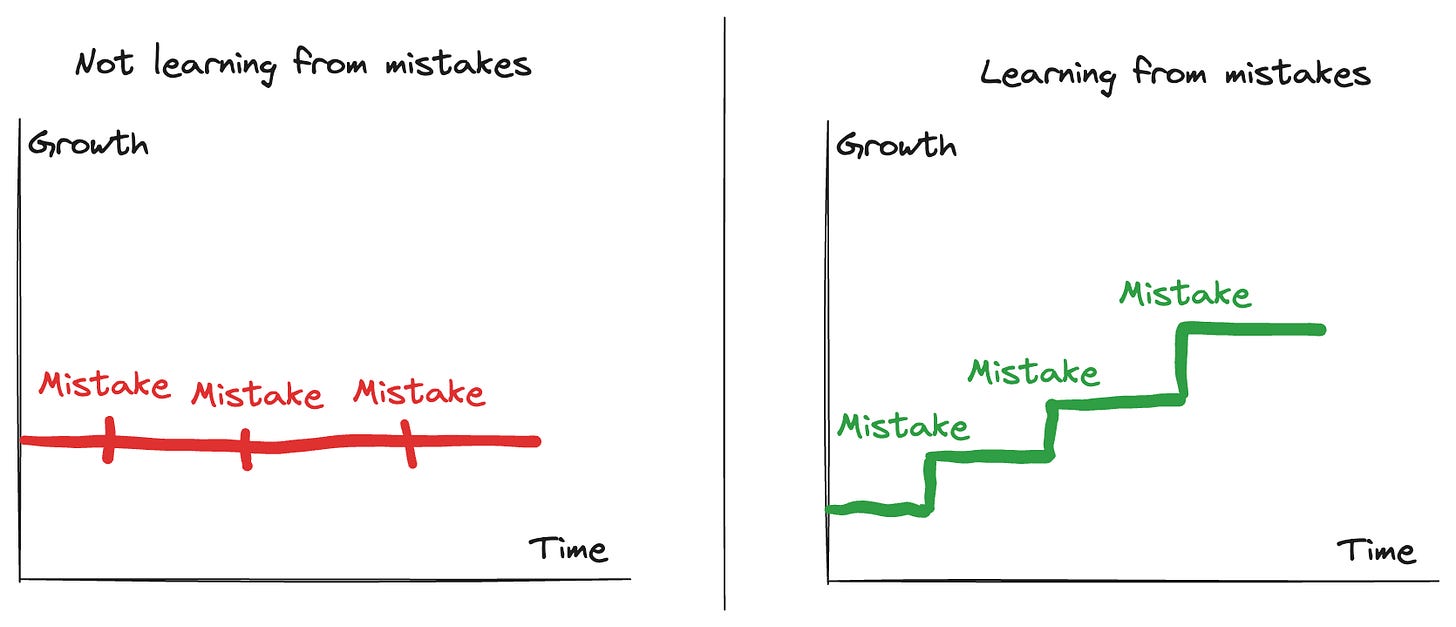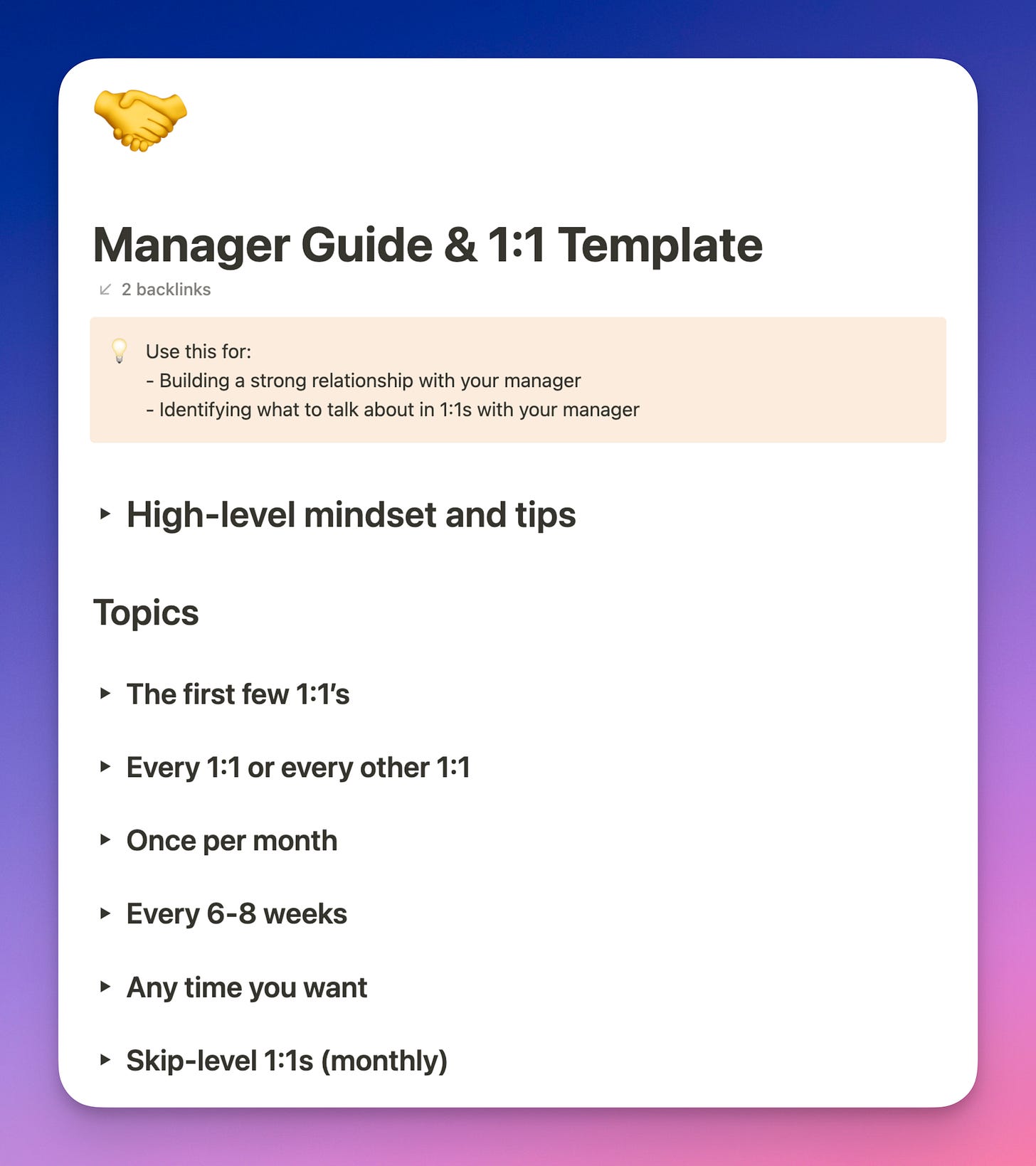Managing up: 3 things I wish I realized sooner
Extracto
Removing uncertainty, managing your priorities, and showing a growth mindset
Contenido
Your relationship with your manager is the most important one to get right.
Having a solid relationship with them:
Opens you up to more opportunities to support your growth
Gives you a strong advocate when promotion time comes
Makes you feel psychological safety
But you’re rarely ever taught how to make that relationship happen. You have to figure it out yourself.
In my first internship at Twitter, things just “worked” with my manager. I got a return offer. My second one, not so much. No return offer.
Why did it “just work” with one manager and not the other?
Luck. As an intern, I had no idea what I was doing, so I was relying on luck—luck that my manager and I would get along, that they would understand me, and that I would understand them. I was an intern trying to survive.
I think that’s expected as an intern. You shouldn’t have to rely on luck though. There’s a lot I know now that I wish I knew then.
Today, I’ll share the 3 most powerful managing up lessons I wish I realized sooner.
Shopify, the world’s leading commerce company providing tools to run a retail business of any size has kindly sponsored today’s newsletter.
Shopify’s new Summer '24 Edition features 150+ updates which help developers.
Two highlights are:
Shopify Flow, enabling you to attach an automation to your app
Hydrogen visual editor, giving you more control over your build.
If your manager asks, “What's the status?” then it's already too late.
The best thing you can do for your manager is remove uncertainty for them.
Most engineering managers were engineers before. They're used to work being in their control. As a manager, that goes away. They need to rely on others and trust that they'll get done what they say.
Here’s what happens when you and your manager discuss what you’re going to work on next:
Some people will lose their mind about the absurdity of this diagram. You discuss work with your manager, and you start doing the work, but they still have all these questions pop up in their head wondering if you’re actually doing it.
But bear with me.
Do you remember when you were assigned group work in school? You and your classmate agreed to do work by a certain date, only for that classmate to show up the day it was due and say, “Ah, sorry, I didn’t get around to it.”
That happened enough that eventually, whenever doing group work, you started wondering, “Can I trust this person?” even with people you had no reason to distrust. You might have even done more work because you worried your teammates wouldn’t finish it. Your manager is going through that, except they probably can’t take on your work. They’re forced to hope you do what you say. But they still worry.
But it’s your job to remove that worry.
There are many ways to do that, but the best way for me has been:
Say what you’ll do
Do it well and update them regularly
Say when it’s done
I incorporated this into my weekly planning and reflection process by creating a running Google Doc with my manager, sharing a brief plan for the week on Monday, and a recap on Friday.
Here’s a rough idea of what it looks like:
Over time, my manager’s mindset shifted from “I’m keeping tabs on Jordan” to “I can keep tabs on Jordan whenever I want. I don’t need to worry. I know he’s always moving forward.”
, a tech lead turned manager, shared his thoughts on this topic:
Finally, here’s one more comment from an engineer turned manager,
:
At my first job at Gusto, I was great at getting my expected tasks done quickly. I’d often have them done in the first few days of a two-week sprint. After that, I added to my plate work that I wanted to do—oftentimes refactoring tasks. My manager was okay with this and “let me do my thing” because I was good at finishing my normal work and wanted to refactor code.
However, it would have been much better if I had used that extra time to figure out my manager’s priorities and find more work aligned with that. My mentee at the time was exceptional at this, and he even surpassed me in promotions, going from Senior to Staff in a single promo cycle.
Understanding your manager and team priorities is why I have a whole section dedicated to them in the weekly planning template I shared last week. I ensure my week’s priorities support those priorities.
Here’s another diagram of how it works:
Taking a step back, this aligns with how companies are structured for a reason. Imagine you’re a CEO. Ultimately, your priority is to increase revenue. However, you see your competitors are clobbering you by releasing new AI features that you don’t have. So you spin up an AI team whose priority is to keep up with your competitors in the AI space. It’s important for the AI team to not lose sight of your ultimate goal though, which is to increase revenue, not only ship AI features for no reason. Their goal should serve yours.
When I’m in manager 1:1s and skip 1:1s, I often ask, “What are your top-of-mind priorities?” and follow up with, “How can I support you more?”
Figure out how your work rolls up to the broader priorities. Focus on those.
The second scariest thing for a manager is seeing you fail.
The first scariest thing is seeing you not learn from it.
In other words, it’s okay if you fail as long as you learn from it and show how you plan to correct it.
I’ve seen this come up as a mentor for interns and junior engineers. The number 1 trait I’m looking for is a growth mindset and learning from mistakes.
Without learning from each mistake, you stagnate like the graph on the left. Interns and junior engineers are expected to grow to mid-level and Senior roles, so not learning from those mistakes is the scariest thing a manager can see and the one thing you must avoid.
The most successful growth-minded engineers do the following:
Proactively ask how to improve, like, “I want to ensure I’m consistently meeting or exceeding expectations in <x> areas. What do you see that I should start, stop, or continue doing to get there?”
Respond to feedback with, “Thank you for the feedback. I am going to work on that by doing <x>”
Follow up on feedback received like, “I tried your feedback and saw <x> results. Thanks again for sharing it with me!”
One trick I do is set a recurring reminder to ask for feedback from my manager and peers more often than the once-a-quarter timeframe the “official” feedback happens. This ensures no surprises when the official feedback cycle comes.
All of the above shows a growth mindset and leads to the graph on the right!
I wrote a guide to build the best relationship with your manager and tackle the most challenging discussions with them. You’ll always know what to talk about in 1:1s and when. It also includes a 1:1 template.
Upgrade to a paid subscription and access the template booklet in your paid subscriber resources page. The last day of the July 4 deal is today (Sunday)!
Remove uncertainty
Say what you’ll do, do it well well and update them regularly, say when it’s done.
I like to use my weekly planning template to give a brief update of my plan on Monday and a recap of what was finished on Friday. Over time, they’ll trust you more to deliver on what you say you will.
Their priorities = Your priorities
Ask, “What are your top-of-mind priorities” and follow up with, “How can I support you more?”
Use my weekly planning template and ensure your priorities align with your manager and team priorities.
Show your growth mindset above all else
Proactively ask how to improve, like, “I want to make sure I’m consistently meeting or exceeding expectations in <x> areas. What do you see that I should start, stop, or continue doing to get there?”
Respond to feedback with, “Thank you for the feedback. I am going to work on that by doing <x>”
Follow up on feedback received like, “I tried your feedback and saw <x> results. Thanks again for sharing it with me!”
Set a recurring reminder to ask for feedback more often than once a quarter. I recommend every 4-6 weeks.
Master the art of influence + communication with Lewis Howes and Charles Duhigg — A long but value-packed video/podcast with tons of tips on effective communication
Don’t give the solution immediately by
on — How to help others around you grow more by not jumping to solutionsMy process for writing this newsletter by
on — The most detailed newsletter writing guide I’ve seen. It’s great if you’re considering starting a newsletter but unsure where to start.
Finally, an early shout-out to the event I’m doing on Taro in one month: 21 Ways to Make Yourself a Better Engineer. I’ll cover my top three tips on career growth, influence, leading projects, technical skills, and more.
A big thank you to the 50+ new paid subscribers since last week. People loved the paid weekly planning template article 🙏
P.S. Here are some other things that may interest you:
My LinkedIn: I write daily, actionable tips to become a better developer
My digital products: Get 100+ actionable insights and 50+ phrases used by the best leaders
Newsletter sponsorships: Feature your product to growth-minded engineers and leaders!
You can also hit the like ❤️ button at the bottom of this email to help support me or share this with a friend to get referral rewards. It helps me a ton!
Fuente: High Growth Engineer






